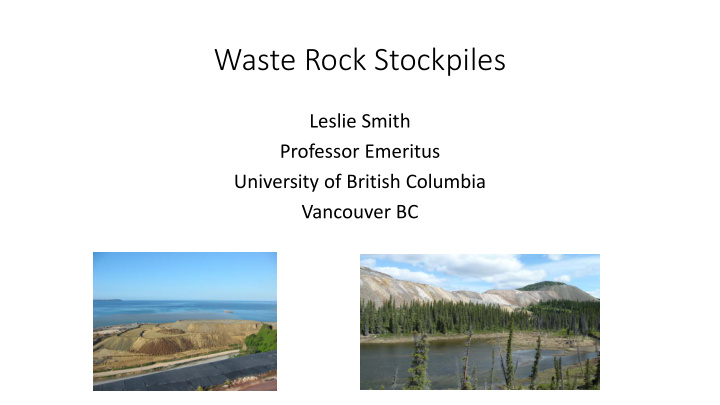



Waste Rock Stockpiles Leslie Smith Professor Emeritus University of British Columbia Vancouver BC
Outline for this Discussion 1. General discussion of processes that influence potential for water quality impacts from waste rock 2. Options for waste rock management 3. Waste rock stockpiles in northern Canada – unique features
Rainfall Waste Rock Management Evaporation Air Flow Leslie Smith Professor Emeritis Chemistry University of British Columbia Vancouver BC Toe seepage Infiltration to Groundwater
Waste rock has a wide range in particle sizes: clay to large boulders Toe seepage with impaired water quality Chemistry, Hydrology, Air Circulation
Chemistry • Sulphide content within waste rock pile, chemical reaction rates • Presence of minerals within pile that can neutralize acidic water • If reactive, time to onset of poor quality drainage (few months to many decades) • Oxygen consumption and replacement • Solutes that are mobile at neutral pH Processes are well understood – challenges relate to site specific data interpretation and extrapolating lab tests and small scale field data to full-scale waste rock piles
Test cells to gain insight to chemistry in field conditions 2017 Constructed in 1995 – British Columbia
Test piles to gain insight to chemistry in field conditions Island in Tropics – South Pacific
Hydrology • Infiltration of water into the waste rock pile • Wet-up of the waste rock pile during / following construction • Drainage of water out of the bottom of the pile • LS rule of thumb estimates for downward rate of water flow in waste rock is 1 – 10 m/year Principal challenge relates to estimating how much of the water that infiltrates a pile contacts how much surface area of reactive minerals in the waste rock pile
Air Circulation Within Waste Rock Piles Oxygen re-supply: Controlled by bulk permeability of the pile • Density differences between warm air and cold air • Changes in barometric pressure (weather patterns) • Wind-driven pressure differences
Porosity and Permeability Measurement in a Large-Scale Permeameter 4 m x 4 m x 2 m high
Waste Rock Management • Waste rock segregation to separate non-acid generating rock from acid generating rock (“Designing for Closure”) • Where protection of water quality requires additional measures: - Submergence of waste rock in water (low oxygen) - Reduce oxygen transfer into the interior of the waste rock pile - Limit infiltration of water through the waste rock pile • Commit to long-term seepage collection and water treatment before release (perpetual care)
Waste Rock Management (Place Rock in Pit) Saskatchewan South Carolina
Engineered soil covers to reduce infiltration of water Closed gold mine in Nevada - 2004
Engineered soil covers to reduce entry of oxygen Test pile in northern Ontario 2017
L Collette 2017
Rainfall Evaporation Permafrost August 2005
Diavik August 2005 Pods of biotite schist in a large mass of granite
Ten-Year Record of Infiltration Estimates for Rainfall at Diavik Test Piles Each year is unique: long-term data is important
Snow hydrology is as important as rainfall in understanding infiltration of water to waste rock
2004 - 2017 UBC U Waterloo U Alberta Carleton U Diavik Diamond Mine INAP, MEND L Collette 2017
Construction of the Covered Test Pile at Diavik Placing Till Layer Placing Upper Waste Rock Layer 2006
Covered Test Pile – View in 2015 No Outflow from the Base of the Covered Pile Since 2014
L Collette 2017
Computer simulation of the thermal and hydrologic e volution of the Covered Test Pile L Collette 2017
Ice accumulation within open voids of a waste rock pile 2015 Blocky ice Ice-filled pores in sand
Monitoring Data • Thermistors for recording temperature profiles with depth • Weather station data to estimate infiltration – can be checked with lysimeters which are designed to measure infiltration through the surface of a waste rock pile • Seepage monitoring (quantity, quality), if possible • Water content in active zone of waste rock pile
Effects of Climate Change • What is the predicted extent of warming in the various regions of northern Canada? • What is the predicted change in the amount of infiltration, if any? • What is the internal temperature response within a waste rock pile? Computer simulations based on sound conceptual models and reliable parameter values Long-term monitoring programs and checking predictions
Recommend
More recommend